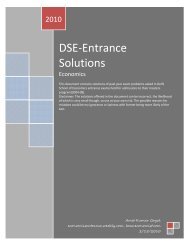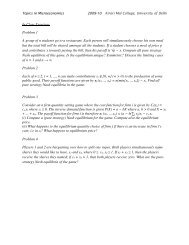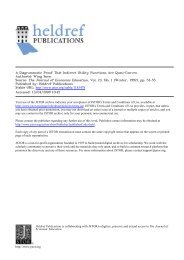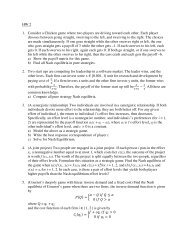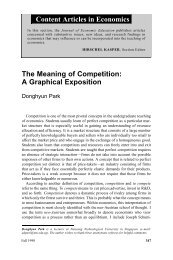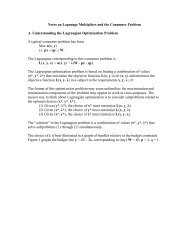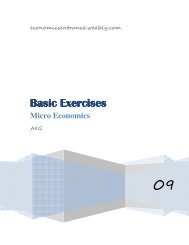2. Each of n ≥ 2, i = 1, ..., n can make contributions s i ∈ [0, w] (w ...
2. Each of n ≥ 2, i = 1, ..., n can make contributions s i ∈ [0, w] (w ...
2. Each of n ≥ 2, i = 1, ..., n can make contributions s i ∈ [0, w] (w ...
You also want an ePaper? Increase the reach of your titles
YUMPU automatically turns print PDFs into web optimized ePapers that Google loves.
Topics in Microeconomics 2009-10 Kirori Mal College, University <strong>of</strong> Delhi<br />
Name: ___________________________<br />
Date: ___________________<br />
Test<br />
Directions: You are required to answer all 2 short questions in part I (20 points each) and to answer<br />
any 2 <strong>of</strong> the 3 questions in Part II (30 points each). For questions with parts, all parts have equal<br />
weight. Please submit complete and carefully written answers.<br />
Part I<br />
Part II<br />
1. There are three voters 1, 2, 3 who have to vote for either <strong>can</strong>didate A or <strong>can</strong>didate B. The<br />
<strong>can</strong>didate who gets at least two votes wins the election. If A wins, all voters get a pay<strong>of</strong>f <strong>of</strong> 1;<br />
if B is elected, all <strong>of</strong> them get 0.<br />
a) Which <strong>of</strong> the following strategy pr<strong>of</strong>iles constitute a Nash equilibrium? (Tick all the correct<br />
options, there <strong>can</strong> be more than one)<br />
(i) Voter 1 votes for B while 2 and 3 vote for A.<br />
(ii) Voter 2 votes for A while the other two vote for B.<br />
(iii) All three voters vote for A.<br />
(iv) All three voters vote for B.<br />
Solution: i), iii) and iv)<br />
b) Do any <strong>of</strong> the Nash equilibria involve players playing weakly dominated strategies?<br />
Solution: i) and iv)<br />
<strong>2.</strong> <strong>Each</strong> <strong>of</strong> n <strong>≥</strong> 2, i = 1, ..., n <strong>can</strong> <strong>make</strong> <strong>contributions</strong> si <strong>∈</strong> [0, w] (w > 0) to the production <strong>of</strong><br />
some public good. Their pay<strong>of</strong>f functions are given by πi (s1, .., sn) = n(max{s1, .., sn}) −<br />
si. Find all pure strategy Nash equilibria in the game.<br />
Solution: All pure strategy Nash equilibrium involves exactly one person contributing w<br />
and others contributing nothing. Formally,<br />
Set <strong>of</strong> Nash Equilibria = {(s1, .., sn)| max{s1, .., sn} = w and ∑1≤ i ≤ n si = w}<br />
3. Two travelers returning home from a remote island discover that the identical antiques<br />
they bought have been smashed in transit. The airline manager proposes the following<br />
scheme to elicit the value <strong>of</strong> the articles.<br />
The two travelers independently submit compensation claims between Rs. 2 and Rs. 100<br />
(claims must be submitted in integer amounts). The airline will reimburse each traveler<br />
at the minimum <strong>of</strong> the two claims. In addition, if the claims differ, a reward <strong>of</strong> Rs. 2 will<br />
be paid to the person making the smaller claim and a penalty <strong>of</strong> Rs. 2 deducted from the<br />
reimbursement <strong>of</strong> the larger claimant.<br />
a) Model this situation as a strategic game.<br />
Players: {1, 2}<br />
Actions: For each i <strong>∈</strong> {1, 2}, compensation claim individual i <strong>can</strong> <strong>make</strong> is ci <strong>∈</strong> {2, 3, …… ,<br />
100}
Topics in Microeconomics 2009-10 Kirori Mal College, University <strong>of</strong> Delhi<br />
Preferences: For each i <strong>∈</strong> {1, 2},<br />
πi(c1, c2) = min{c1, c2} if c1 = c2<br />
min{c1, c2}+2 if ci < max{c1, c2}<br />
min{c1, c2} - 2 if ci > min{c1, c2}<br />
b) Find Nash Equilibria <strong>of</strong> the game.<br />
Solution: Unique Nash equilibrium is (2, 2)<br />
4. Two individuals, Mukesh and Anil are bargaining over Rs 100. Mukesh moves first and<br />
proposes a split <strong>of</strong> (x; 100 - x) (i.e. Mukesh gets x and Anil 100 - x). Anil responds to Mukesh<br />
<strong>of</strong>fer by saying either Yes or No. If he says Yes, then the split (x; 100 - x) is implemented; if<br />
he says No, both <strong>of</strong> them get zero.<br />
a) What are the strategies <strong>of</strong> Anil and Mukesh in this game?<br />
Solution: Strategy set <strong>of</strong> Mukesh = {x|0 ≤ x ≤ 100} =[0, 100]<br />
Strategy set <strong>of</strong> Anil = {f|f :[0, 100]→{Yes, No}}<br />
Strategy <strong>of</strong> Anil is a function from all possible <strong>of</strong>fers that Mukesh <strong>can</strong> <strong>make</strong> to a set that<br />
contains two alternatives i.e. either accept or reject an <strong>of</strong>fer.<br />
b) Can the split (50; 50) be a Nash equilibrium outcome in this game? If Yes, provide the<br />
equilibrium strategy pr<strong>of</strong>ile. If No, explain why?<br />
Solution: Yes<br />
Strategy pr<strong>of</strong>ile:<br />
sMukesh = 50 i.e. Mukesh <strong>of</strong>fers 50 to himself<br />
sAnil(x) = Yes if 0 ≤ x ≤ 50<br />
= No if x > 50 i.e. Anil will accept all <strong>of</strong>fers that give Mukesh atmost 50 and reject all<br />
other <strong>of</strong>fers.<br />
c) What is the subgame-perfect equilibrium in this game?<br />
Solution:<br />
Strategy pr<strong>of</strong>ile:<br />
sMukesh = 100 i.e. Mukesh <strong>of</strong>fers 100 to himself<br />
sAnil(x) = Yes if 0 ≤ x ≤ 100 i.e. Anil will accept all <strong>of</strong>fers.<br />
d) Suppose that the bargaining described above carries on for another round. Once again if<br />
Anil says Yes to Mukesh's <strong>of</strong>fer <strong>of</strong> (x; 100-x), the game ends. However if he says No to<br />
Mukesh's <strong>of</strong>fer he gets to <strong>make</strong> a counter<strong>of</strong>fer (instead <strong>of</strong> the game ending). There is now<br />
only Rs 80 left to bargain over. Suppose Anil <strong>of</strong>fers (y; 80 - y) (i.e. Mukesh gets y and Anil 80<br />
- y). Mukesh now responds to this <strong>of</strong>fer by saying Yes or No. If he says Yes, then the split (y;<br />
80 - y) is implemented. Otherwise the game ends with Mukesh and Anil getting pay<strong>of</strong>fs <strong>of</strong> 50<br />
and zero respectively. What is the subgame-perfect Nash equilibrium outcome <strong>of</strong> this game?<br />
Solution: Outcome will be the following: Mukesh will <strong>of</strong>fer 70 i.e. the split (70, 30) and <strong>of</strong>fer<br />
will be accepted.<br />
5. Consider a market in which there are two firms, both producing the same good. Firm i’s cost<br />
<strong>of</strong> producing qi units <strong>of</strong> the good is Ci(qi) = 9 for qi > 0 and Ci(0) = 0 for each i <strong>∈</strong> {1, 2}; the<br />
price at which output is sold when the total output is Q is Pd(Q) = max{16 – Q, 0}, where Q<br />
= q1 + q<strong>2.</strong> <strong>Each</strong> firm’s strategic variable is output and the firms <strong>make</strong> their decisions
Topics in Microeconomics 2009-10 Kirori Mal College, University <strong>of</strong> Delhi<br />
sequentially: one firm chooses its output, then the other firm does so, knowing the output<br />
chosen by the first firm.<br />
a) Model this situation as an extensive game.<br />
Players: {1, 2}<br />
Terminal Histories: {(q1, q2)| q1, q2 <strong>≥</strong> 0}<br />
Player function: P(∅) = 1, P(q1) = 2∀ q1 <strong>∈</strong> [0, ∞)<br />
Preferences: For each i <strong>∈</strong> {1, 2}, πi(q1, q2) = qiPd(q1+q2) – Ci(qi) = qimax{16 – q1 – q2, 0} – 9<br />
b) Find the subgame perfect equilibrium and outcome <strong>of</strong> Stackelberg’s duopoly game.<br />
Equilibrium:<br />
Strategy <strong>of</strong> firm 1 → q1 = 10<br />
Strategy <strong>of</strong> firm 2 → q2 (q1) = (16 – q1)/2 for q1 < 10,<br />
= 0 for q1 <strong>≥</strong> 10<br />
Outcome: (10, 0)


![2. Each of n ≥ 2, i = 1, ..., n can make contributions s i ∈ [0, w] (w ...](https://img.yumpu.com/19311695/1/500x640/2-each-of-n-2-i-1-n-can-make-contributions-s-i-0-w-w-.jpg)

